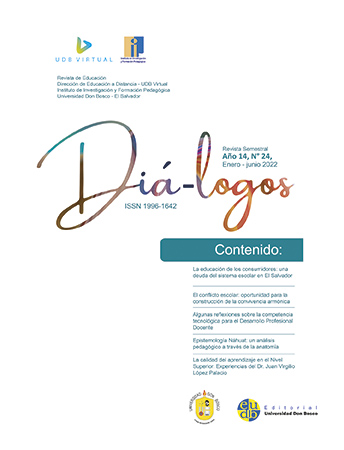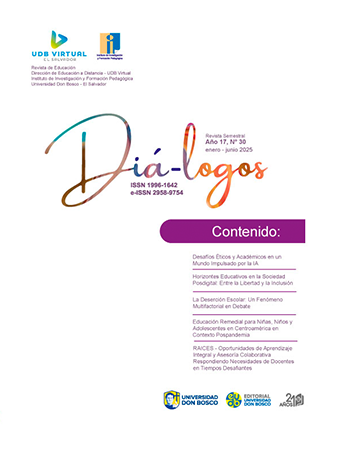The school conflict: An opportunity to create a harmonious coexistence
Keywords:
Bullying, relationships between peers, social representation, coexistence, student behaviorAbstract
DOI: https://doi.org/10.5377/dialogos.v24i1.14768
In Salvadoran schools there is bullying between peers in its different forms. This phenomenon has manifested itself from subtle bullying such as “nicknames” to physical attacks that have ended in hospitalizations or student suicide. This is the reason why a theoretical approach is presented from the social representations that the teacher builds from his understanding and approach to situations that arise during the school day. This research is based on theory with the contributions of Dan Olweous and his postulates on bullying and Tania Rodríguez, regarding social representations. To understand this issue, it was delimited into four dimensions: understanding, approach, training and regulations from the social representation of teachers. In this sense, the methodological section is developed from the hermeneutic approach, to understand and interpret the ideas and perspectives of the phenomenon that teachers have about bullying in public schools, through the techniques of semi-structured in-depth interviews, participant observation and review. of regulatory documents. Teachers are protagonists in this study, since their perspective is key to creating meaningful learning from conflict.
Downloads
References
Barbera, N., Inciarte, A. (2012). Fenomenología y hermenéutica: dos perspectivaspara estudiar las ciencias sociales y humanas. Multiciencias, 12 (2), pp. 199-205. Universidad del Zulia Punto Fijo.
Cuellar-Marchelli, H. y Góchez G. (2017). La pertinencia de las estrategias para prevenir la violencia escolar en El Salvador. FUSADES.
Di Napoli, Pablo. (2018). Reflexiones críticas sobre la noción de bullying desde un caso de estudio. Un análisis de las luchas simbólicas por el poder de nominación en el ámbito escolar. Espacios en blanco. Serie indagaciones, 28(2), 33-48. http://www.scielo.org.ar/scielo.php?script=sci_arttext&pid=S1515-94852018000200003&lng=es&tlng=es
Fuster, D. (2019). Investigación cualitativa: Método fenomenológico hermenéutico. Propósitos y Representaciones, 7(1), 201-229. http://dx.doi.org/10.20511/pyr2019.v7n1.267
Galdámez, R. y Lemus, C. (2020). Representaciones sociales del docente salvadoreño sobre el acoso escolar entre estudiantes de tercer ciclo en la escuela salvadoreña, Universidad Centroamericana José Simeón Cañas, Antiguo Cuscatlán.
Jodelet, D. (1986). La representación social: fenómenos, concepto y teoría. En Moscovici, S. (Comp.), Psicología social II. Pensamiento y vida social. Psicología social y problemas sociales, 469-494. España: Paidós.
Macarena Morales & Verónica López. (2019). Políticas de convivencia escolar en América Latina: Cuatro perspectivas de comprensión y acción. Archivos Analíticos de Políticas Educativas, 27(5). http://dx.doi.org/10.14507/epaa.27.3800
Matos, C., Fuentes, C, Montoya, C., De Quezada, J. (s.f) Didáctica: Lógica de Investigación y Construcción del Texto. De investigación y construcción del texto científico. Facultad de Ciencias de la Educación, Centro de Investigaciones.
Ministerio de Educación, Ciencia y Tecnología. (2018). Política Nacional para laConvivencia Escolar y Cultura de Paz. San Salvador, El Salvador.
Mora, M. (2002). La teoría de las representaciones sociales de Serge Moscovici. Athenea Digital, 2. http//blues.uab,es/athenea/num2/mora.pdf
Morin, E. (1999). Los Siete saberes necesarios para la educación del futuro.Biblioteca Digital UNESCO. UNESDOC.https://unesdoc.unesco.org/ark:/48223/pf0000117740_spa
Olweus, D. (1996). Problemas de hostigamiento y de víctimas en la escuela. Perspectivas, XXVI (2), 357-389.
Picardo, O., Escobar, J., y Pacheco, B. (2008). Diccionario Enciclopédico de Ciencias de la Educación. 2a. Ed.
Ruiz Olabuénaga, J. (2003). Metodología de la investigación cualitativa. Bilbao: Universidad de Deusto Sautu. pp. 3-47
Temporetti, F. (1977). Mi credo pedagógico. John Dewey. Centro Editor de América Latina.
Published
How to Cite
Issue
Section
License

This work is licensed under a Creative Commons Attribution-NonCommercial-NoDerivatives 4.0 International License.









